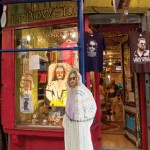One sunny Thursday morning my wife, Judith and I, having just left our French lesson near Union Square and having a half hour to spare until our next appointments nearby, needed a place to sit and refresh ourselves. Fortunately we were only a block from Broadway which had been recently redesigned by the Department of Transportation (DOT) to accommodate pedestrian and bicycle use. The two lane south bound vehicular traffic was largely diverted west at 18th Street and the eastern most travel lanes were resurfaced in tan and green. Planters filled with fountains of towering green plants were installed protecting the chartreuse chairs and tables roofed with bright blue umbrellas. There were seats available under the shade of the umbrellas where we could eat a pastry covered Dogmatic.
It was then we discovered a peaceful lively environment relatively free of auto traffic which had been diverted a half block north. I noticed the predominance of pedestrians and cyclists in the sun filled street. I could enjoy the contours of 19th century architecture, the crestings on the Second Empire roof of the former Lord and Taylor on 19th Street, the extraordinary blue sky puffed by white clouds, the cooling breeze. Here in a relatively small space DOT had with a minimum of cost, but a maximum of creative imagination and traffic know-how, had created a space to serve all of us.
For over a hundred years traffic engineers had seen streets simply as a way to move goods and people on wheeled vehicles. Conventional traffic engineering manuals regarded pedestrians as impediments to motor vehicles. Streets were not seen as spaces experienced by human sensibilities or frames for architecture, though evolving zoning laws did and do relate building bulk and height to the width of streets.
Along comes Janette Sadik-Khan with a team of brilliant and inspired designers who envisioned streets in a more human rather than mechanical context. Rather that pursuing changes through the medium of slow capital intensive reconstruction she approached urban spaces as a designer artist. The DOT team began to reconfigure spaces such as Union Square, Madison Square, Herald Square and Times Square as true public spaces. At the same time Ninth Avenue, Eighth Avenue, Columbus Avenue and Broadway were essentially repainted to enliven those public spaces with little more than a paint brush and friendly street furniture. Private entrepreneurs and John Q. Public filled in the blanks with their human needs.
A similar rebirth has taken place at Ninth Avenue and 14th Street where a Pain Quotidien has been installed to serve those seated on the newly created plaza in the middle of the avenue. Here north and south bound vehicular traffic clash and become diverted to the east and west. Here we are a block from the High Line, another urban wonder, one of the greatest of this century. South of this down as far as Gansevoort Street there will emerge another new urban space being created by the redesign of Ninth Avenue to make it more of a pedestrian friendly urban space. Time will tell how well it will work for us. I truly hope that the next administration will not drop the ball and will continue this momentum by persuading Transportation Commissioner Sadik-Khan to stay at the helm.



